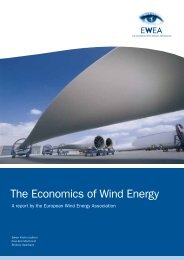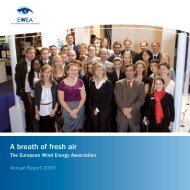Offshore Electricity Infrastructure in Europe - European Wind Energy ...
Offshore Electricity Infrastructure in Europe - European Wind Energy ...
Offshore Electricity Infrastructure in Europe - European Wind Energy ...
You also want an ePaper? Increase the reach of your titles
YUMPU automatically turns print PDFs into web optimized ePapers that Google loves.
Annex d – details of results<br />
FiGuRe 13.7: m<strong>in</strong>imum beneFicial distance FROm the w<strong>in</strong>d FaRm tO shORe FOR diFFeRent <strong>in</strong>teRcOnnectOR capacities [km].<br />
(aveRaGe absOlute pRice diFFeRence OF €7.5, distance wF tO <strong>in</strong>teRcOnnectOR OF 40km, unbalanced FlOw with 30% OF<br />
pRice diFFeRence FlOw<strong>in</strong>G tOwaRds One cOuntRy)<br />
M<strong>in</strong>imum distance<br />
WF to shore (km)<br />
1,500<br />
1,200<br />
900<br />
600<br />
300<br />
0<br />
100<br />
200<br />
Area A Area B<br />
Area C<br />
300<br />
Spatial correlations of w<strong>in</strong>d power<br />
production between countries<br />
With the simulated w<strong>in</strong>d power time series, also the<br />
spatial correlations between <strong>in</strong>dividual countries<br />
have been <strong>in</strong>vestigated. The results are shown <strong>in</strong><br />
Table 13.1, which confirms the f<strong>in</strong>d<strong>in</strong>gs expla<strong>in</strong>ed<br />
above. These figures can be used <strong>in</strong> the prelim<strong>in</strong>ary<br />
assessment of new <strong>in</strong>terconnectors that are meant for<br />
trad<strong>in</strong>g w<strong>in</strong>d power.<br />
D.II Case-<strong>in</strong>dependent model –<br />
sensitivity analysis<br />
400<br />
The case-<strong>in</strong>dependent model was built <strong>in</strong> order to<br />
carry out pre-analysis of beneficial cases of hub-tohub<br />
connections and tee-<strong>in</strong> connections. Furthermore<br />
the results of case-<strong>in</strong>dependent model can serve as<br />
quick guidel<strong>in</strong>es for the modular offshore grid development<br />
and can give <strong>in</strong>sight to policy decision makers,<br />
stakeholders, TSOs and <strong>in</strong>terconnector and w<strong>in</strong>d farm<br />
developers.<br />
The case-<strong>in</strong>dependent model analyses the benefits of<br />
a project compared to the conventional solution. The<br />
model takes <strong>in</strong>to account a variety of parameters that<br />
<strong>in</strong>fluence the results. If the parameters of the project<br />
500<br />
600<br />
700<br />
800<br />
900<br />
1000<br />
W<strong>in</strong>d farm capacity (MW)<br />
1,500 MW <strong>in</strong>terconnector 1,000 MW <strong>in</strong>terconnector 500 MW <strong>in</strong>terconnector<br />
are known, the reader can position his project with<strong>in</strong><br />
the field of parameters and read the economic viability<br />
of the project from the results given.<br />
The model is expla<strong>in</strong>ed below but the detailed results<br />
are available on www.offshoregrid.eu due to the large<br />
amount of data.<br />
D.II.I Sensitivity analysis on the<br />
benefit of tee-<strong>in</strong> solutions<br />
Impact of <strong>in</strong>terconnector capacity<br />
The impact of the <strong>in</strong>terconnector capacity on the<br />
break-even distance is different for different w<strong>in</strong>d farm<br />
capacities. These can be divided <strong>in</strong> three areas, as<br />
can be seen <strong>in</strong> Figure 13.7:<br />
• Area A: W<strong>in</strong>d farm capacities up to the <strong>in</strong>terconnector<br />
capacity of 500 MW.<br />
For w<strong>in</strong>d farms with a small capacity, the break-even<br />
distances are equal for every <strong>in</strong>terconnector capacity.<br />
The part of the <strong>in</strong>terconnection capacity which is<br />
higher than the w<strong>in</strong>d farm capacity is unconstra<strong>in</strong>ed<br />
<strong>in</strong> both the conventional solution as the tee-<strong>in</strong> solution.<br />
It does therefore not lead to a difference <strong>in</strong> the<br />
m<strong>in</strong>imum beneficial distance.<br />
132 <strong>Offshore</strong>Grid – F<strong>in</strong>al Report<br />
1100<br />
1200<br />
1300<br />
1400<br />
1500<br />
1600<br />
1700<br />
1800<br />
1900<br />
2000









